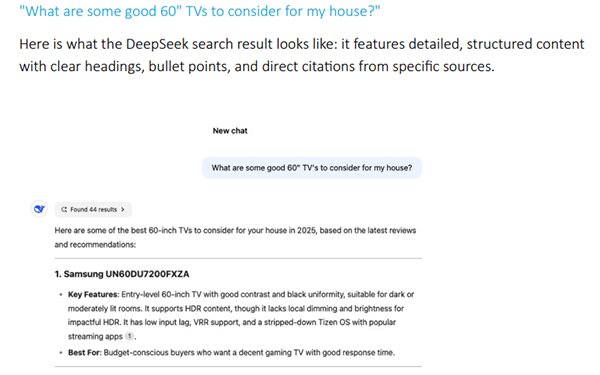
OpenAI may have been the first to release a reasoning model and
others followed. Search engines did not tell users why it would serve specific information, but that has changed with AI.
Industry experts are just now seeing the difference between AI agents,
platforms and search engines, and how marketers and advertisers need to manage both, according to Jim Yu, CEO at BrightEdge. He said the two concepts are becoming clear.
“It’s a
battle between the titans, and when there’s a new entrant that might disrupt things they all move fast to implement a similar feature,” he said.
Similar to the latest version of
Microsoft Bing that surfaced this week, it added reasoning in terms of how it comes up with results, along with citations and logic as to why it served the content.
“Copilot will cite
where it got its information at the end of its summary,” Yu said. “Users can click on these citations for fact-checking, similar to
what Google has done with AI Overviews. Its ‘alternate AI search’ mode will likely offer organized answers with defined headers for complex questions.”
advertisement
advertisement
If AI like DeepSeek
becomes a shopping agent or concierge, how do marketers influence that? It's a different approach to search and it has big implications, he said.
DeepSeek was the first AI engine that
served content based on a search query without building a search engine, and that is why the company has shaken up the industry. The technology looks at what the user asks, and thinks about how to
approach the query.
For example, does it need to search for additional information, analyze what the websites offer, and then come back with an answer? It’s important to note that the
ability to gather and analyze the information before serving it up seems more like an AI agent being developed in browsers than a traditional search engine.
“AI agents are a
little bit like a self-driving car,” Yu said. “You can see places to go, but once you start trusting it to do certain things, it does it for you.”
Yu said it is very
expensive to build a search engine that offers quality information. That is why when Chinese hedge fund High-Flyer announced the company, analysts were excited.
The technology thinks about how
to go about answering the questions by first analyzing the information. It will tell the person searching that it knows information up until a specific day, and then try to find additional research
before answering the question.
The cost structure also changes, he said. DeepSeek showed companies can create really good AI with fewer parameters. Tuning it to get closer to the hardware will
create a much more efficient model.
DeepSeek is much more transparent when it comes to where and how it finds information to serve back to the user. This makes it a little different from
traditional search engines like Google, which was built as a search-first by indexing content across the web and then embedding powerful AI.
While Perplexity is an AI-first engine that started
with its own index, it augmented the technology with search. ChatGPT started as an AI-first engine and then licensed information from Microsoft Bing.
Microsoft initially partnered with Novell
for PC network compatibility, and later integrated it into its operating system.
Novell was a software company that created network operating systems, collaboration tools, and other products
for managing information technology. Attachmate acquired the company in 2011.
BrightEdge released a report with more information explaining the differences.